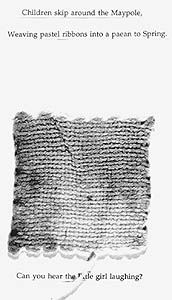![[MetroActive Arts]](/arts/gifs/art468.gif)
[ Arts Index | Santa Cruz Week | MetroActive Central | Archives ]
Mesa artist's desert canvases and poems tell a windswept story
By Christina Waters
THE GEOLOGICALLY driven work of Northern Arizona artist Judy Tuwaletstiwa creates an embrace of both earthy textures and earthly text. Forming a wraparound snapshot of the artist's creative process--both conscious and unconscious--the show, entitled "text/subtext," offers a large landscape of canvases imprinted with sand, clay, fiber, sticks and feathers.
Lining the walls of the smaller adjoining gallery are pages from Tuwaletstiwa's The Canyon Poem, a fine-arts limited edition book of images and text, as well as pages from a provocatively personal book-in-progress. The sense of moving through metaphors, of swimming through the artist's altered states, is palpable.
Together the desert canvases and words reflect a lifetime of reflection; a life lived within sight of Native American kivas on the Hopi reservation of Black Mesa.
What powers Tuwaletstiwa's imagery, both verbal and visual, is the play of surface against depth. The repetitive patterns of bits of basswood embedded in gritty black surfaces appear to tease and lull the senses. Here the elaborately worked surfaces, obviously related to textile patterning, exist as permeable membranes through which a windswept narrative speaks. Looked at close up, the sand-encrusted canvases bearing exquisite rows of tiny pheasant feathers, work as visual trances. From a distance, however, they can be read as runes of some long-lost civilization, or perhaps the long-lost past of the individual observer.
The hypnotic patterns of Tuwaletstiwa's natural elements multiply upon the panels like organisms hoping to be discovered. The overall effect is a connection with the dreamtime of all aboriginal cultures, somehow familiar, undeniably strange. Bumps of life, attempting to be born, threaten to erupt through some of the "sand paintings." Others form dry lakebeds of geometry through which we detect barely contained chaos.
Playing counterpoint to the silent canvases, the pages of Tuwaletstiwa's Canyon Poem open us to the artist's inner voice, yet without the cloying confessionalism that mars so much feminist show-and-tell. In some of these beautifully mounted pages a ghost text appears to bleed through, illegible words we can't quite decipher--like dreams that evaporate as we awake.
When the text portion of the exhibit works best, it is by refusing to play conceptual tricks. Granted there is concept at work in the calculatedly random organization of words, texture and bits of natural material. The desert ephemera gathered and gleaned by the poet/artist is never treated ironically, however. Crossing the threshold beyond postmodernism, Tuwaletstiwa transforms the stuff of the harsh landscape--inner and outer--with tenderness and dignity.
That these abstract canvases and distilled words manage to make dialogue is due to the sheer force of the artist's will. Not everyone will feel inclined to unravel this text. The spiritual risks might be too taxing. Those adept at dream analysis, however, will want to take a closer look.
Copyright © Metro Publishing Inc. Maintained by Boulevards New Media.
![]()
 Sand Storm
Sand Storm
Text/subtext, an exhibit by Judy Tuwaletstiwa, is at the Mary Porter Sesnon Gallery, Porter College, UCSC, through May 13. Gallery hours are Tues-Sun, noon-5pm; 831.459.3606.
From the May 2-9, 2001, 1999 issue of Metro Santa Cruz.